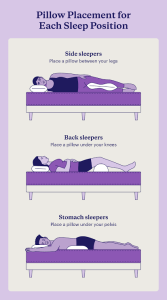Neck pain can be a frustrating and persistent problem, often caused or worsened by something as simple as the wrong pillow. Since we spend about a third of our lives sleeping, having proper neck support is essential for spinal alignment, muscle relaxation, and overall comfort. The right pillow can make a huge difference in preventing or alleviating neck pain, but choosing one isn’t as simple as grabbing the fluffiest option off the shelf. Your body size and preferred sleep position play a crucial role in determining the best pillow for you. Here’s how to go about choosing the right pillow for you.
How Your Pillow Affects Neck Pain
A good pillow should keep your head, neck, and spine in a neutral position, so your neck isn’t bent too far forward, back, or to the side. If your pillow is too high or too low, it can strain your neck muscles, leading to stiffness, headaches, and even long-term posture issues.
Poor pillow support can also contribute to:
- Morning neck pain and stiffness
- Tension headaches
- Shoulder discomfort
- Poor sleep quality
Choosing the Right Pillow for Your Sleep Position
Your preferred sleeping position greatly influences the type of pillow you need. Here’s a breakdown of what works best for each position:
Back Sleepers
Back sleepers need a pillow that supports the natural curve of the neck without pushing the head too far forward. A medium-loft pillow (8-13 cm thick) made of memory foam or a contour design can provide gentle support. Look for a pillow with a slight cervical curve to cradle the neck and keep the spine aligned.
Side Sleepers
Side sleepers require more support to keep their head level with their spine. A pillow that’s higher and firmer (10-15 cm thick) helps fill the gap between the head and shoulders. Memory foam, latex, or a firm down-alternative pillow can work well. Some side sleepers also benefit from placing a small pillow between their knees to keep the hips aligned.
Stomach Sleepers
Stomach sleeping is a problematic position for neck pain because it forces the head to turn to one side, straining the neck. If you must sleep this way, choose a very thin pillow (under 8 cm thick). You might also consider placing a thin pillow under your chest or pelvis to help keep your spine in better alignment.
Choosing the Right Pillow for Your Body Size
In addition to sleep position, your body size and frame matter when selecting a pillow:
- Petite adults may need a lower-loft pillow to prevent excessive neck bending.
- Average-sized people generally do well with a medium-loft pillow.
- Broad-shouldered individuals often need a thicker pillow, especially if they sleep on their side.
Final Tips for Reducing Neck Pain
- Replace your pillow every 1-2 years since old pillows lose their support.
- Consider material preferences — memory foam molds to your shape, latex provides firm support, and down is soft but less structured.
- Keep your mattress in mind — a softer mattress may require a lower-loft pillow, while a firm mattress might need a thicker one.
- Consider finding a specialist store to have a ‘pillow fitting’ where you can try different pillows and find the best one for you!
If you consistently wake up with neck pain, it may be time to reassess your pillow. Investing in the right one can lead to better sleep, less pain, and a healthier spine.
ALM Remedial servicing the Yarra Valley, Lilydale, Seville, Wandin, Dandenong ranges areas.




